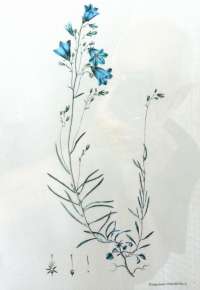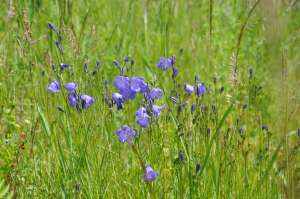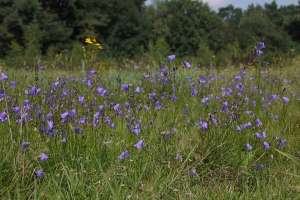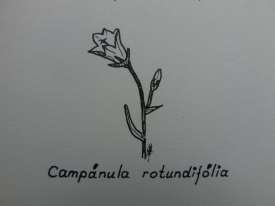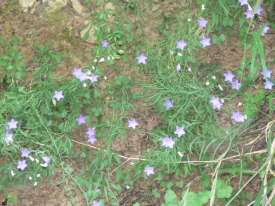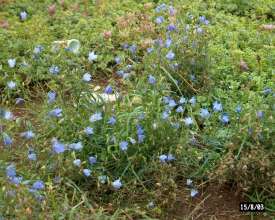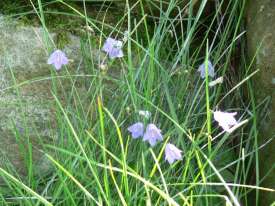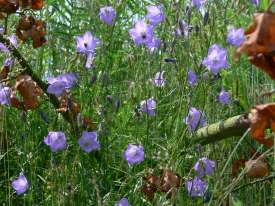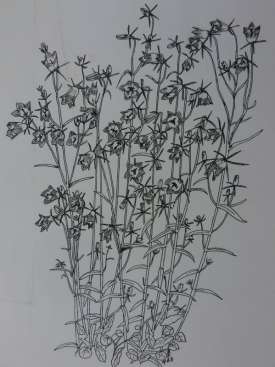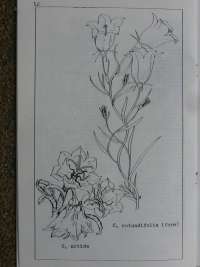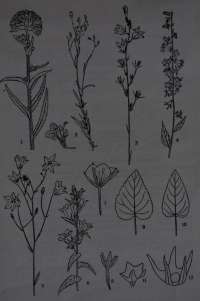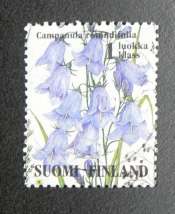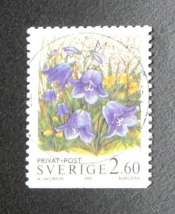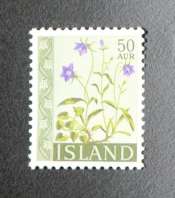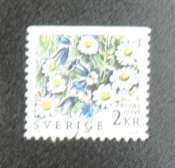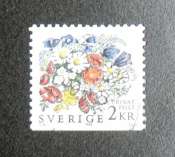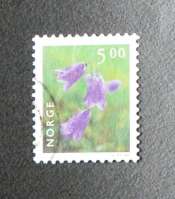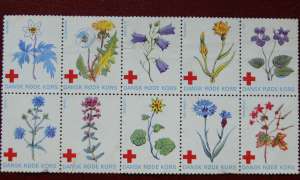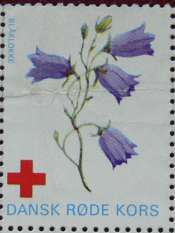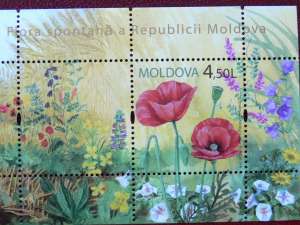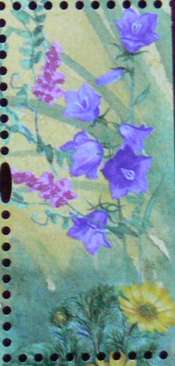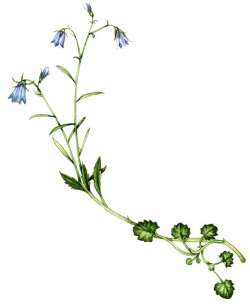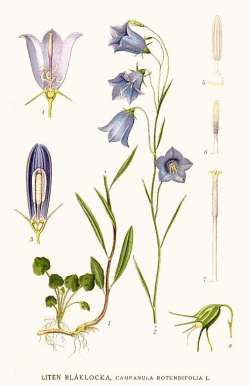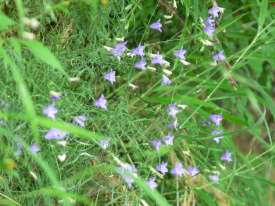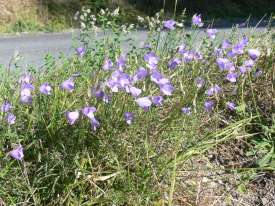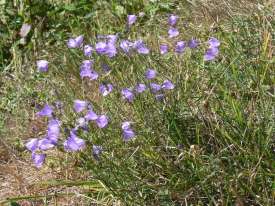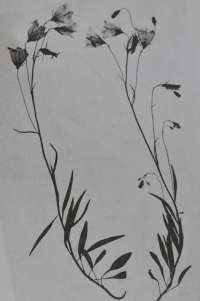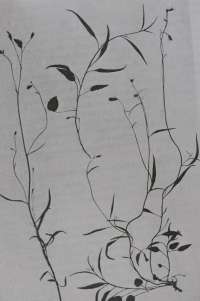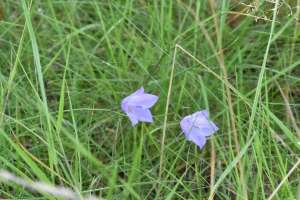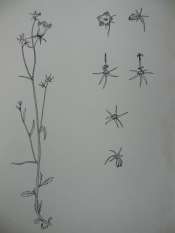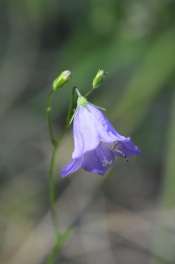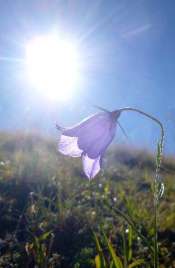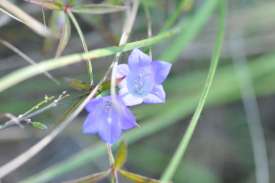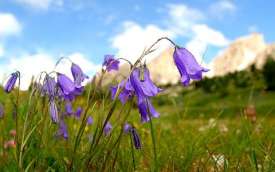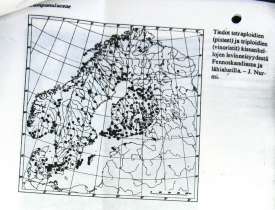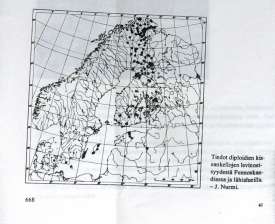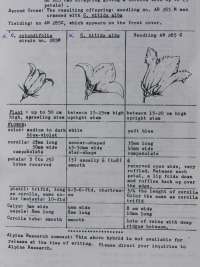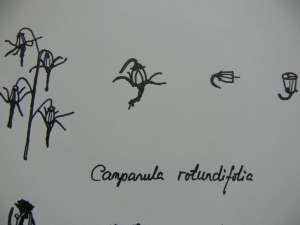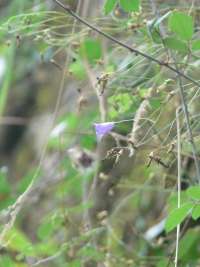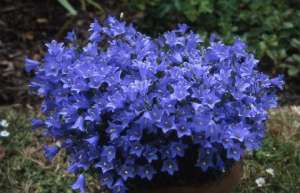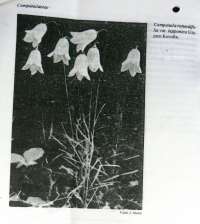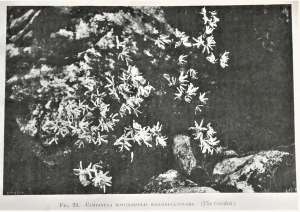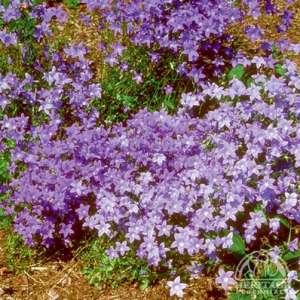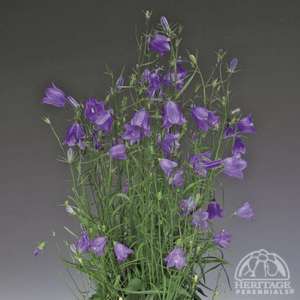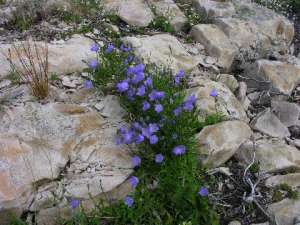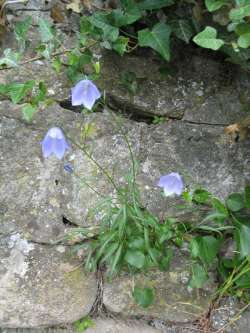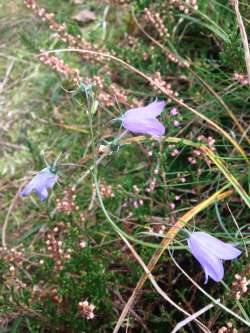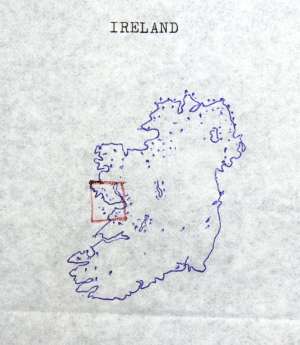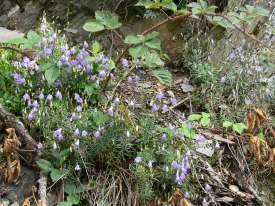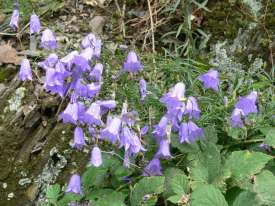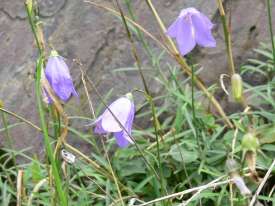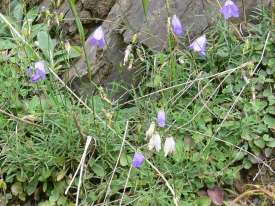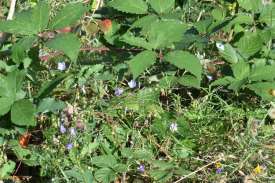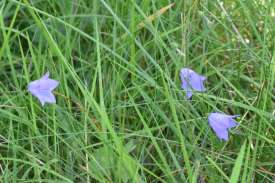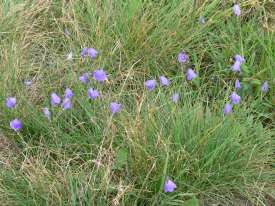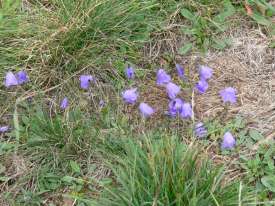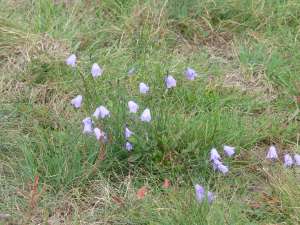Inhoud
rotundifolia
Also: rotundifoliae
Campanula rotundifolia
L.
rotundifolia L. (DWARF FORM) (M79153): Orig 019023-0156-79, Locn 1A NA, geo: 57548, rec: SEED: 1ab: 1, dis: DEER PARK, ayr: 79,1)
rotundifolia LINN.: Orig 012267-0284-75, Locn 1B 36, geo: 51004, rec: PLNT: 1ab: 1, dis: MT.SELESSIE,CHILLI WH, ayr: 75,2) rotundifolia LINN.: Orig 0103396-0062-72, Locn 1B, rec: SEED: 1ab: 1, dis: SWEDEN:OSTERGOTLAND, ayr: 72,3) rotundifolia LINN.: Orig 007532-0116-73, Locn 1B, 1B 34, geo: 51004, rec: PLNT: 1ab: 1,1, dis: SLOCAN S. 20MI, B.C., ayr: 73,4)Infrageneric Taxa
Fam. des Campanulacées. Section 2: Calice sans appendice. Groupe 1: - Capsules á 3 loges, sessiles, dressées5)
Campanula rotundifolia complex
Nékteré druhy z komplexu C. rotundifolia se vyskytují na pomérné malém uzemí, napr. v Krkonosích je to C. bohemica Hruby/Syn.: C. corcontica Sourek/ a v Jesenících C. gelida Kovanda. Oba tyto druhy mají lodyhu vyrazné hranatou a dlouze brvitou, poupata jsou vzprímená, stejné jako je tomu u C. rotundifolia. Tím se odlisují od druhu C. scheuchzeri Vill., s nímz byvají casto zaménovány, ktery se vsak v CSSR nevyskytuje, roste v Alpách a jizní Evropé a má poupata nící. Zajímavym druhem je také C. serrata /Kit./ Hendrych/syn.: C.napuligera Schur/, ktery má rovnéz poupata nící, lodyzní listy pilovité a koren repovité ztlustly. Jemu se velmi podobá C. recta Dulac / syn.: C. linifolia Lam. non L./ z Pyrenejí, ktery vsak má lodyzní listy celokrajné. C. moravica je nápadná velmi bohtym kvétenstvím, ztlustlym oddenkem a zdrevnatélymi tobolkami. Kromé Moravy a Slovenskaroste téz v Rakousku, Madarsku, Jugoslávii a Rumunsku. De komplexu C. rotundifolia patrí téz C. cespitoas Scop. a C. cochlearifolia lam., o kterych vsak je pojednáno samostatné. U nás se komplexem C. rotundifolia zabyvá dr. Kovanda, ktery jej také zpracoval pro dílo Flora Europaea vol. 4.6)
Nomenclatuur
Campanule á feuilles rondes, á fleurs dóubles - Campanula rotundifolia Lin., var. flor. duplic.7).
L. (1753)Section VII: Trachelium Neilr. (1859)8) Moris (1840-43), non L. - 9) Pasquale Campanula rotundifolia x Campanula cochlearifolia (f. umbrosa)? L. Vacc. (1911). - V. d'Aosta tra Pre-St.-Didier e la Balme.10) Campanula rotundifolia x Campanula Scheuchzeri? D. Torre et S. (1912). - Alto Adige a Cles ed al Ritten.11) Synonym: Campanula heterodoxa Hort., not Vest ex Roem. & Schlt., synonym; Campanula Marchesettii Witasek; synonym Campanula petiolata A. DC.; synonym Campanula rotundifolia var. alaskana A. Grey; Synonym Campanula sacajaweana. Peck. Synonym: Campanula linifolia.12) Campanula x Jenkinsae Hort. Presumed to be a hybrid between Campanula carpatica cv ‘Alba’ and Campanula rotundifolia. Synonym: Campanula rotundifolia Moris (1840-43), non L. - Campanula macrorrhiza var. sardoa Levier ex Tanf. (1888) - Campanula sardoa Levier ex Nym. (1889-90)13) Other plants may be offered under the name Campanula olympica Boiss, especially Campanula rotundifolia cv. ‘Olympica’ 14). Campanula uniflora - Campanula uniflora L. = Campanula Scheuchzeri- Section Melanocalyx. It has an affinity with Campanula rotundifolia, similar habitats, but it is almost never reflected in the bot. literature. Text V.I.Kobauri15)Campanula rotundifolia L. - Kissankello (rotundifolius, lat., pyorealehtinen)16). Plants offered under the name Campanula Morettiana Rchb.f. are likely to be Campanula rotundifolia. Campanula polymorpha Witasek. A Russian species near Campanula rotundifolia but apparently not in culture; material listed as Campanula polymorpha be Campanula rotundifolia, Wahlenbergia trichogyna or Wahlenbergia gracilis.17)
Names
E.: Bluebell, Harebell, Common Harebell, Air-Bell, Witches'-Thimble, Lady's-Thimble - This bluebell has a large number of common names. Harebell may relate to the fact that this plant is sometimes found in areas inhabited by rabbits (hares). This same plant grows in Scotland where it is popularly known as the Bluebells of Scotland or Scotch bluebell.18)
Fr.: Campanule a feuilles rondes,Clochette, Clochette-des-murs, Campanule á feuilles rondes, á fleurs dóubles
Campanule a feuilles rondes (pl.382: 1.798, tige fleurie; 1.798 b., 1.798 c., 1.798 d., 1.798 e. et 1.798 f.)19)NL.: Grasklokje;
D: Rundblattrige Glockenblume, Grasglockenblume, Grasglockchel
Fi.: Kissankello
Vlaams: Grasklokje, Piespotjes
I: Campanella-Soldanella
Habitus
Indigéne - Vivace - Tiges nombreuses, étalées, puis ascendantes, gréles et rameuses. Feuilles radicales longuement pétiolées, á limbe arrondi ou ovale, crénele; les caulinaires lancéolées-linéares, décroissantes. Calice á lobes étalés; corolle petite, elargie de la base au sommet, á lobes aigus, et présentant dans son intérieur, par suite de dédoublement, plusieurs autres corolles s'emboitant les unes dans les autres. Plante curieuse et assez jolie, fleurissant de Juin-Juillet en Septembre.20).
Campanule à feuilles rondes, tiges fleuries ou plantes fleuries de cinq sous-espèces. Toutes ces plantes ont pour caractère commun principal de présenter les pédoncules des boutons non recourbés avant la floraison, les étales ou dresses. Les feuilles situées le long des tiges fleuries sont étroites, ovales-allongées, ovales ou à contours un peu en losange, mais ne dépassent pas, en général, 2 centimètres de largeur, et sont souvent beaucoup moins larges. Ce sont des plantes vivaces à parties souterraines constituées par une tige grêle et rameuse ayant des racines non épaissies (très rarement la tige souterraine est épaissie). Les tiges fleuries ne proviennent que des ramifications soit de la tige principale issue de la germination, soit d'une courte tige formée par un rameau de la tige souterraine, soit encore d'une tige développée par un bourgeon adventif ne sur les racines; la plante se perpétue et se multiplie par ces divers procédés (Dubard). (On à décrit diverses anomalies de cette espèce: fleurs à 4 sépales, 4 pétales, 4 étamines; fleurs à plus de 5 sépales, plus de 5 pétales et plus de 5 étamines; corolle doublée; racines aeriennes se developpant sur les feuilles; anomalie speciale de la fleur avec accroissement particulier des petales et multiplication des parties semblables de la fleur qui avait donne lieu, par erreur, à l'etablissement du genre spécial Dampierrea; etc.). Le type principal se reconnaît aux tiges qui sont grêles, courbées et redressées, presque sans feuilles dans leur partie supérieure, au calice dont les divisions sont dressées ou étalées, aux fleurs épanouies qui sont penchées et dont la corolle à des lobes ordinairement étalés, aux tiges souterraines grêles et peu ou pas ligneuses.21)
Descriptio. Affinis Campanula linifoliae Decand. et Campanula rotundifoliae; at foliorum mediorum forma, pube et habitu differt. Radix simpliciuscula, longissima, tenuis. Caulis basi longe inter rupium fissuras serpens, dein adscendens, saepe pedalis, interdum biuncialis, imo uncialis. Folia inferiora in junioribus tantum conspicua, ovalia, obtusiuscula, obsolete crenata; inferiora et media petiolum habent 1/2 ad 2 unc. saepe longum, laminam ejusdem longitudinis, suntque obsolete repanda, denticulis paucis, minutissimis, ciliis paucis in basi petioli; summa brevia, linearia, pauca, bracteas quoque sistunt. Flores pedicellis 1/2 - unc. longis, patentibus. Calyx tubo 1 - 2 lin. longo, laciniis angustissimis 6 - 7 lin. longis. Corolla 7 -9 lin. longa. Pistllum corollam aequat. Stamina breviora. In pascuis Campanula Herminii ab ovibus depasta uniflora est, parva, foliis paucis. Haec est. Campanula angustifolia pumila monantha lusitania. Tournef. Inst. p. 122. aegre ab adfinibus distinguenda, hinc a Villarsio ad Campanula Scheuchzeri seu Campanula linifolia Decand. relata.22)
8-40cm. 23)E pianta perenne a rosette basali di foglie dalla forma ovale-tondeggiante, ondulata al margine, e con stoloni sotterranei molto estesi. I fusti, prostrato-ascendenti variano in altezza dai 10 ai 60cm. Questa specie e stata da molti autori suddivisa in diverse sottospecie. Secondo alti sistematici, si tratta invece di vere e proprie specie che noi indichiamo scegliendo quelle ritenute piu importanti Campanula linifolia ha piccole foglie basali reniformi, le superiori lineari, strettamente ovali, sessili e pelose al margine; i fusti alti da 10 a 35cm. portano da 1 a 6 fiori penduli, rotondo-campanulati, lunghi 3cm. circa, con sottili penduncoli e lobi del calice lunghe quanto la corolla; Campanula scheuchzeri alta sino a 40cm. ha fusto glabro e foglie inferiori lunghe e strette, le caulinari lineari e sessili; i fiori sono singoli, ampiamente campanulati con lobi ricurvi e corolla azzurro-purpureo o violetto lunga 2-3cm.24)
Perenni. Pianta c. s., glabra o piu rr. pelosa, a fusti semplici o ramosi (5-60cm.).25)
Die erste Achse tragt eine unbegrenzte Laubblattrosette, wahrend die blutentragenden Sprosse seitlich an derselben entstehen. Sie variiert nicht unbetrachtlich und ist in eine Anzahl Arten und Unterarten zersplittert worden. Ihr nahestehend sind: Campanula pusilla Hke., Campanula linifolia (Lam.) DC, Campanula Scheuchzeri Vill. und weiter Campanula carnica Schiede.26)
Campanula scheuchzeri, Considerata da molti autori una sottospecie della piu comune Campanula rotundifolia, ha fiori prevalentemente solitari di colore da violetto ad azzurro-purpureo.27)
A polymorphic aggregate of perennial forms, typically producing a loose rosette of leaves and stolons, eventually forming a mat from which arise erect flower stems or decumbent scabrous, simple to freely branched, 3-18 in. (to about 1m, usually much smaller) high.
Kleine, meist rasenbildende Arten mit traubigen, meist wenigblutigen Blutenstanden.28)
The rootstocks slender and elongated. Throughout its wide area of distribution this species is highly variable, but with us it is rather constant.
The plants from Termignon (French Alps 1400m) deviated in many characters from typical European Campanula rotundifolia L. but resembled Campanula scheuchzeri Vill. In many respects. Typical pressed specimens have been shown to Professor H. Merxmuller, Munich, who has kindly given me his opinion of the taxonomical position of the plants. According to Merxmuller the plants are not identical with either Campanula rotundifolia or Campanula scheuchzeri, but might be interpreted as belonging to a hybrid between these species. In some characters the plants approach Campanula bocconei Vill. But it is not possible to refer the plants to this taxon. They have among other things much too large flowers.
The habit of the plants appears from Fig. 3-4. They deviate from typical Campanula rotundifolia by early flowering, few large flowers, almost glabrous stem bases and the shape of the subbasal leaves with their shallow spaced dentation. The corollas are up to 2 cm long and the sepals are tapering, 1cm long and 1mm broad at their bases. In habit the plants have lanceolate some referred to the arctic Campanula gieseckiana, which als have pnaceolate stem leaves gathering towards the base (cf. Bocher 1960 Plate III-IV).
The Termignon plants differ from Campanula scheuchzeri by being not entirely glabrous below. They bear some poorly developed very short hairs of the same type found in Campanula rotundifolia. They have furthermore erect or horizontal, but not drooping flowers, and never very few or a single flower only. Finally they lack hairs on the leaf-bases as found in typical Campanula scheuchzeri.
While the intermediate morphological position of No. 81 between typical Campanula rotundifolia and typical Campanula scheuchzeri supports a hybrid origin three other facts contradict such an explanation. First the chromosome number of the supposed parent species is 68, secondly there is a high pollen fertility in No. 81 (no shriveled or empty grains, few per cent dwarf grains), and thirdly no seeds were obtained after crossings with a tetraploid Campanula rotundifolia (2n=68; “Campanula linifolia Scop.” From the Botanical Gardens in Greifswald).
The meiotic behavior is difficult to interpret. The occurrence of heteromorphic bivalents, rings and other configurations may as well be the result of hybridization as of translocations or both. At the present stage of knowledge the conclusion may be drawn that the plant from Termignon (No. 81) cannot be a primary hybrid between species with 2n=68. However, it may have envolved from such a hybrid by subsequent chromosome repatterning and increase in chromosome number. In many respects it behaves as a stabilized entity which perhaps deserves taxonomical recognition29).
Bluebell or harebell is a rosette-forming, upright perennial that typically grows to 20“ tall. From a basal rosette of small, rounded, long-stalked, basal leaves (to 1” wide) rise wiry, thread-like stems clad with narrow, alternate, linear leaves (each to 1-3“ long). Genus name comes from the Latin word campana meaning little bell in reference to the bell-shaped flowers. Specific epithet is in reference to the rounded basal leaves.30)
Kissankello on varmasti kelloistamme yleisimmin tunnettu - ja kuitenkin kasvitieteilija kohtaa juuri siina vaikeimmat luokitteluongelmat. Laji kuuluu ainoana kotimaisena kellona ryhmaan Heterophylla, jota luonnehtivat tasasoukkia varsilehtia selvasti leveammat ja lyhyemmat, jopa munuaismaiset aluslehdet. Tahan viittaa myos kissankellon tieteellinen nimi. Ryhmaan kuuluu Euroopassa nelisenkymmenta lajia, niista suurin osa levinneisyydeltaan suppea-alaisia Keski- ja Etela-Euroopan vuoristokasveja.
Kissankello on ryhman laaja-alaisin laji. Se kasvaa melkein koko Euroopassa etelaisimpia osia lukuun ottamatta, Pohjois-Amerikassa ja Aasian pohjoisosissa. Se muuntelee suuresti eri puolilla aluettaan, ja eri tyyppeja on kuvattu milloin alalajeina, milloin lajeina. Laajassa mielessa lajin piiriin kuuluvat mm. Campanula polymorpha Wit. Karpaateilta, Campanula dubia DC. Newfoundlandista, Campanula latisepala Hulten Alaskasta, Campanula langsdorffiana Fischer Ita-Siperiasta seka arktisten alueitten laaja-alaiset Campanula giesekiana Vest ja Campanula groenlandica Berlin.
Suomen ja Ruotsin etela- ja keskiosissa seka Etela-Norjassa esiintyva kissankellotyyppi kasvaa yleisena niityilla ja kedoilla, ojan pientareilla, teiden varsilla ja muilla samantapaisilla paikoilla, yleensa nimenomaan hiekkaperaisilla keveilla mailla. Varsi on tavallisesti 30-50cm korkea ja runsashaarainen. Kukkien lukumaara vaihtelee melkoisesti, mutta yleensa kukkia on aika runsaasti, ehka 5-15. Terion pituus on tavallisesti 15-19 mm. Ymparistotekijat voivat kuitin muuttaa ominaisuuksia aika lailla. Esim. merenrantaniitylla kasvi jaa usein melko matalaksi, vaikka samat yksilot puutarhassa kasvatettuina voivat kehittya aivan normaalikokoisiksi.31).
Hoogte 25 cm.32)
Leaves
Feuilles radicales longuement pétiolées, á limbe arrondi ou ovale, crénele; les caulinaires lancéolées-linéares, décroissantes33).
Les rosettes stériles et parfois les feuilles les plus inférieures des tiges fleuries ont un limbe élargi le plus souvent en chaeur renversé et porte sur un pétiole plus ou moins allongé. Les feuilles de la base des tiges fleuries sont le plus souvent détruites lors de la floraison, mais quelquefois elles ne se sont pas développées du tout et alors les parties moyenne et supérieure de la tige fleurie portent des feuilles relativement grandes et assez rapprochées les unes des autres.34)
Rosette basali di foglie dalla forma ovale-tondeggiante, ondulata al margine. E portano sulla parte prostrata foglie lungamente picciolate ed ovali, appuntite, piu o meno dentate, mentre sulla porzione eretta divengono sessili, strettamente lineari e prive di denti.35)
Fg. cauline tutte lineari o strettam. lanceolate, rr. ellittiche. Fg. delle rosette sterili rotondato-cordate od obovate, crenate o seghettate, spesso scomparse all'epoca della fioritura; le cauline variabili. 36) .Leaves often in rosettelike clusters at or near base, rosette leaves long-petioled, round-cordate to elliptic or oblanceolate, ovate to orbicular to about 1 in. ore 5cm long and wide, across, entire or toothed, stem leaves sessile, linear to lanceolate-ovate, early-withering. Cauline leaves numerous, linear to narrowly lanceolate, smooth, to 1 dm. long and 3 mm. wide.
Der, wie bei den verwandten Arten eine unbegrenzte Laubblattrosette tragende Wurzelstock hat rundliche, die blutentragenden Stengel haben schmal lanzettliche Blatter.
From a basal rosette of small, rounded, long-stalked, basal leaves (to 1” wide) rise wiry, thread-like stems clad with narrow, alternate, linear leaves (each to 1-3“ long). Basal leaves usually wither early and disappear before the flowers form.37)Flowers
Calice á lobes étalés; corolle petite, elargie de la base au sommet, á lobes aigus, et présentant dans son intérieur, par suite de dédoublement, plusieurs autres corolles s'emboitant les unes dans les autres.Plante curieuse et assez jolie, fleurissant de Juin-Juillet en Septembre.38).
Juin-oct. Les fleurs, d'un bleu lilace ou plus ou moins violacé, rarement blanches, s'epanouissent depuis le mois de mai jusqu'au mois de septembre. Le calice est à divisions très étroites, même depuis leur base. Les dimensions de la corolle peuvent varier du simple au quadruple, mais sa longueur ne dépasse pas ordinairement 25 millimètres; cette corolle est sans poils et se terminé par 5 divisions élargies qui ne mesurent guère que le quart de sa longueur totale. Le style est à 3 stigmates. 39)
I fiori possono essere solitari o portati in radi racemi, eretti, penduli o semipenduli, su peduncoli slanciati ed hanno corolla azzurra, campanulata a lobi ricurvi, misurante 1 o 2cm. Fiorisce da maggio a novembre. 40)
Giu.-Ag. Corolla a lobi non ristretti alla base e percio separati da seni acuti. Fi. inclinato-pendenti. Calice a lobi patenti o riflessi. Corolla azzurra (rr. bianca). 41) . Flower measuring, between 25 - 40mm (1 - 1 1/2 inch.)42) June-October. Flowers as many as 15 in loose, terminal lax racemes or sometimes solitary, erect in bud, nodding to ascending in flower, calyx without appendages, lobes short, narrowly triangular to linear-subulate, usually spreading, entire, corolla white to deep lavender-blue, about 1 in. long, mostly 12-25mm, campanulate, the tube 7-15mm. long. Corolla lobes ovate-oblong, abruptly pointed at tips, 5-8mm. wide. Filaments 2.5-4.5mm. long, abruptly dilated and ciliate on the basal portion; anthers 4-6 mm. long.
It is noted for producing attractive, bell-shaped, nodding blue flowers (each to 1/2” long) that bloom singly or in small clusters from the stem tips throughout summer (June-September).43)
Chromosomes - Zytologie
Number of diploid chromosomes (2n=34).
A study of microtome slides of vigorous root tips from pot grown plants and stained with Feulgen showed that the chromosome number of Cult. No 81 is 2n=72+4 B-chromosomes (see Figs. 1a-b). This surprising number was definitively established by countings of some very clear meiotic first telophase plates having n=36+Bs (Figs. 1d-e) and a corresponding stage in a single restitution nucleus, 2n=72+Bs (fig. 1f).
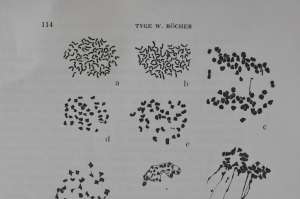
Behaviour of B-chromosomes.
The four B-chromosomes belong to three size classes. The two smallest are of the same size and during meiosis they very often form a pair (Fig. 2, c, d, f, I, j). All four B-chromosomes may undergo precocious divisions, which take place during late diakinesis (Fig. 2g), metaphase, anaphase I Ifigs. 1c, 1h, 2e, 2j) or later (Fig. 1e, 1f). They are frequently observed lagging at telophase I and may also divide here (Fig. 1g). In all respects the B-chromosomes of No. 81 resemble those described in tetraploid Campanula rotundifolia (Bocher 1960, Figs. 10-12, 119-129, 138-166). In one case (Fig. 1c) a bridge formed by a dividing B-chromosome was seen. The bridge may be a result of a union of two chromatid ends in a B-chromosome with a precociously divided centromere. No acentric fragment was deractable. The deviating number 2n=72 may have arisen in two ways: (1) as an octoploid number within a series with 9 as a basic number, (@) as an aneuploid number connected with the series with 17 as a basic number (2n=34-36-72).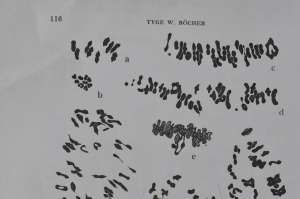
(1) Larsen (1954) was the first to find a Campanula species with 9 as the basic number, viz. Campanula lusitanica (or loeflingii) which has 2n=18. This number was later found also by Gadella (1962), A. Fernandes (1962) and myself (in material raised from seeds from the Coimbra Botanical Gardens, see Fig. 2a-b). The size and shape of the chromosomes correspond with the majority of the chromosomes in No. 81. Considering the grat number of countings recently made in Campanula (Bocher 1960, Gadella 1962 and 1963, Merxmuller & Damboldt 1962, Podlech 1962) it is remarkable that so far only few plants with 2n=36 have been found. Before plnats with 2n=18 or 36 have been found in the Campanula rotundifolia group it is obviously very doubtful whether this group consists of two lines with two basic numbers. On the other hand, as recently pointed out by A. Fernandes (1962), the number 9 would make it much easier to understand how the various 17-series arose seeing that accrosses between species with 2n=16 and 2n=18 would give rise to allotetraploids with 2n=34. (2) An aneuploid development leading from 2n=34 to 2n=36 is another possibility in spite of the fact that aneuploid numbers have only rarely been reported in the genus. Very recently, a clear case of aneuploid evolution was demonstrated by A. Fernandes (1962) who found 2n=20 in Campanula transtagana, a species described by R. Fernandes (1962) as being closely related to Campanula lusitanica which has 2n=18.
How the increase in chromosome number took place is difficult to explain. Perhaps B-chromosomes have played a role. As found in maize by Roman (1947) segments from A-chromosomes are sometimes translocated to the B-chromosome. Some B-chromosomes in Campanula may have fused with detached segments from the other chromosomes which cannot be distinguished from A-chromosomes. Other possibilities for increase in number also presuppose chromosome breaks and reciprocal translocations. According to many observations translocations occur frequently in the Campanula rotundifolia group thus making an explanation of the chromosome number 2n=72 as an aneuploid number most probable 44).
Es wurden 7 Pflanzen (Campanula rupestris), vom locus classicus bei Levadia (Bootien) untersucht. Bei einem Exemplar fanden sich in den somatischen Platten der Wurzelspitzen zwei akzessorische Chromosomen (B-Chromosomen). Leider konnten keine Meiosestadien dieser Pflanze untersucht werden, so dass eine endgultige Aussage uber ihren Wert und ihr Verhalten gegenuber den Standatdchromosomen des normalen Satzes nicht moglich ist. Die B-Chromosomen besitzen zirka 1/3 der Grosse der kleinsten Standardchromosomen und sind im Gegensatz zu diesen selbst in sehr fruhen Prophasen schon stark kontrahiert. Deutlich ist in diesem Stadium in den meisten Fallen eine submediane Einschnurung zu erkennen. Bocher (1960) halt es fur sehr wahrscheinlich, dass die von ihm bei Campanula rotundifolia gefundenen B-Chromosomen euchromatisch sind. Dagegen waren die von uns bei Campanula rupestris gefundenen B-Chromosomen eindeutig stark heterochromatisch. Es konnten keine morphologischen Unterschiede zwischen der Pflanze mit akzessorischen Chromosomen und den ubrigen Pflanzen der Population gefunden werden. - Bei allen Individuen konnte in den somatischen Platten immer ein SAT-Chromosomenpaar mit verschieden grossen Satelliten beobachtet werden. 45)
Kromosomiluvultaan tama yleisin kissankellotyyppi on tetraploidi, 2n = 68. Tama tyyppi edustaa Campanula rotundifolia ahtaasti kasitettyna, ja sille ilmeisesti kuuluu nimialalajin asema. Toinen tyyppi kromosomiluvultaan myos tetraploidi, kasvaa Skandien tunturialueella tunturien rinteilla, kallionpengermilla ja purojen varsilla. Se on edellista selvasti matalampi, mutta ,elko vankkavartinen, n. 15-30 cm korkea, seka iso- ja harvakukkainen. Usein varren latvassa on vain yksi kukka. terio on tummansininen ja n. 20-28 mm pitka. Suuren kokonsa ja levean kellomaisen muotonsa vuoksi kukka muistuttaa melkein kurjenkellon kukkaa. Taman ja edellisen tyypin valiset erot sailyvat, tosin eivat aivan yhta selvina kuin luonnossa, niita rinnakkainkin viljeltaessa, kuten jo G.Turesson klassissa kokeissaan on osoittanut.Kissankellon eri kromosomilukua olevat tyypit eivat nayta helpolla risteytyvan keskenaan keinotekoisesti; luonnonoloissa on triploideja Pohjois-Euroopan alueelta loydetty kahdesti (Utsjoelta ja Tanskasta). Tallainen triploidi risteyma on kuitenkin marto. Taman perusteella voisi eri kromosomirotuja pitaa omina lajeinaankin. Kun niiden erottaminen kaytannossa on kuitenkin suuren muuntelun ja tuntomerkkien paallekkaisyyden vuoksi vaikeaa, lienee selvinta pitaa kaikkia samaan lajiin kuulivina, kenties parhaiten alalajeina.46).
Breeding
The cross is numbered AR 285 C. The parents are:
* First Cross: Campanula rotundifolia forma heterodoxa x seedling mutant no. 285 (an offspring giving a corolla with up to 25patals). * Second Cross: The resulting offspring;: seedling no. AR 285 M was crossed with Campanula nitida alba. * Yielding: no. AR 285 C, which appears on the front cover.47)Campanula rotundifolia Seedling AR 285 C. Plant: between 15-20cm high, upright stem. Flower: color: soft blue. Corolla: 35mm long, 430mm wide, campanulate, petals: 6, recurved open wide, very ruffled. Between each petal, a lip folds down and ruffles back up over the edge. Pistil: 3/4 the lenght of corolla. Color the same as corolla trifid. Calyx: 8mm wide, sepals: 10mm long. Corolla tube: lote of veine with deep ridges between. Alpina Research comment: This above hybrid is not available for release at the time of writing. Campanula rotundifolia strain no. 285 M. Plant: up to 50cm high, sprawling stem. Flower: color: medium to dark blue-violet. Corolla: 25mm long, 30mm wide, campanulate, petals: 5(to25) lobes recurved. Pistil: trifid, long as corolla, samen color (mutants: 10-fid). Calyx: 3mm wide, sepals: 8mm long. Corolla tube: smooth.
Fruit
Les fruits murs sont penchés et s'ouvrent par 3 orifices situés vers leur base. 48)
Capsules inclinees.49)
Seed available, in small quantity. Species actually grown or used for breeding 50) Calyx lobes erect to spreading or reflexed in fruit, to 1cm long and 2 mm. wide. Capsule pendent, obovoid to ellipsoid or subglobose, prominently ribbed, 4-8mm. long, 2-4mm. in diameter51). Kapsel nahe am Grunde aufspringend (Hangende Kapseln springen meist nahe am Grunde, aufrechte nahe den Kelchb. auf. Man kann daher im Allgemeinen die Art des Aufspringens aus der Stellung der verbluhten Bl. erschliessen, besonders wenn diese gestielt sind.) Sect. I Medium Tourn. (als Gatt.). B. Triloculares. Kapsel 3facherig (seltener bei ein- und derselben Art hier und da auch 5facherig) 52)
Bit of notes: Campanula caespitosa; Seed of 5 different sources have been supplied to us. Though most Botanical Gardens are very reliable for true-to-name seed, one source sent seed of Campanula rotundifolia forma under an old, but erroneous, taxonomy. As some members have receive seed of Campanula caespitosa from us, you might find that the seedling pans will germinate 2 species. Since we found this error, we have corrected this erroe. We apologize. 53)
170-72. Orig. Amér. du N., Eurasie, North. Amer., Eurasia. Fr. Campanule á feuilles rondes. Ang. Bluebell. De: Jard., Bot. de Montréal, Montreal, P.Q., 3-2-72. Descr.: Sem. 1. Jard. omb., G-1, 16 - 16-7-73, 2. Jard. omb., G-1, 16 - 3-6-74, 3. Jard. omb., G-1, 16 - 20-8-75, 4. Jard. omb., G-1, 16 - 15-9-76, 5. Jard. omb., D-1, 16 - 28-1-82,54)Varieties
On à décrit 6 sous-espèces, 2 races et 14 variétés de cette espèce; les 6 sous-espèces, les 2 races et les principales variétés sont les suivantes.55)
NOTA. - Sono da riferirsi alla polimorfa Campanula rotundifolia le seguenti entita distinguilbili dallo specialista e rappresentanti per lo piu delle forme individuali, intermedie od incrociate fra le var. sopra descritte: 56)
* Campanula rotundifolia var. alaskana A.Grey synonym Campanula rotundifolia* Campanula rotundifolia var. alaskana Gray E.K. Toogood
1978-76. Orig. Hort. Fr. Campanule d'Alaska. Ang. Alaskan Harebell. De: Harlow Car gard., The Northern Hort. Soc., Harrogate 8-4-76. Descr.: sem.57) * Campanula rotundifolia var. alba Seed available, in small quantity. Species actually grown or used for breeding 58)* Campanula rotundifolia var. albiflora
* Campanula rotundifolia var. alpicola
* Campanula rotundifolia var. alpicola congestiformis
* Campanula rotundifolia ssp. arctica - dwarf - see also Breeding.
* Campanula rotundifolia ssp. baumgartenii (J.Beck.), Rouy. Synonym: Campanula baumgartenii J. Beck. est a rechercher en Lorr. or., ou elle a ete signalee. Elle se distingue de la subsp. rotundifolia par sa tige anguleuse, ses feuilles caulinaires relativement grandes (Jusquá env. 6cm. de long sur 1cm. de large), ses boutons floraux inclines a dresses (alors qu'ils sont toujours dresses chez la subsp. rotundifolia).59)
* Campanula rotundifolia ssp. Bertolae (Colla, 1835) - Corolla campanulato-imbutiforme o bislungo-campanulata, ca. ristretta in basso. - Fusti semplici o ramosi, alti 3-60cm. Fg. delle rosette sterili rotondate o cordate alla base, a picciuolo sottile, sempre piu lungo della lamina e sino a 3-4 volte. Fg. cauline infer. ca. lungam. picciolate. Corolla mediocre, lunga 10-20mm. Tubo calicino senza grosse glandole a forma di papille o talora con glandole appena distinguibili. Corolla ca. largam. campanulata od anche tubuloso-campanulata ma in piante elevate ed a racemo ca. ramificato. Piante di luoghi erboso o sassosi, a rz. sottile. Cassula pendente. Lacinie calicine per lo piu erette.
Fg. radicali marcite all'epoca della fioritura. Piante sempre elevate (30-60cm.) ed a racemi ramosi. Corolla mediocre, lunga 10-15mm., tubuloso-campanulata. Fg. cauline tutte intere. - Colli di Vittorio, M. Baldo, Comasco sulla Grigna e sul M. Baro, C. Tic. a M. S. Giorgio, Alpi Cozie e Mar. ad Entraque, App. ligure-parmig., tosc. sopra Fivizzano e nel Casentino, marchig., piceno-abr. e camp. al M. Meta. (Vallese Monten. Austr. Ungh.). - Campanula Re Colla (1835) = Campanula rotundifolia var. velutina Re (1821), non DC. (f. pilosa) - Campanula tenuifolia Auct., non Hoffm.60)* Campanula rotundifolia ssp. Caespitosa (Scop., 1772) - Corolla campanulato-imbutiforme o bislungo-campanulata, ca. ristretta in basso. - Fusti semplici o ramosi, alti 3-60cm.
Fg. delle rosette sterili (e talvolta le cauline infer.) ristrette alla base in picciuolo larghetto, unguale alla lamina o piu breve. - Fusti cespugliosi (8-30cm.), terminati in racemo plurifloro, talora ramoso (rr. fusti 1-flori). Calice a lobi lunghi 1/3-1/4 della corolla. Corolla oblungo-campanulata. - Alpi or. dal Goriz. al Trent. ed Alto Adige, da radiarsi dal Campanula Tic. e dal Piem. e forse anche dal Comasco; 5-7. (Eur. centr.) - Campanula antirrhina Schleich. (1815)(f. pilosa)61)* Campanula rotundifolia var. cespitosa (Scop.) Pers.
Campanula cespitosa Scop. = Campanula caespitosa auct. = Campanula pumila Sims = Campanula rotundifolia var. cespitosa (Scop.) Pers. 62) * Campanula rotundifolia var. cf. Seed available, in small quantity. Species actually grown or used for breeding 63)* Campanula rotundifolia var. cochlearifolia (Lam., 1783) - Corolla emisferico-campanulata, rotondata in basso. - Fusti cespugliosi, alti 4-20cm., 1-6-flori, rr. con racemo ramificato. Fg. radicali come nel tipo. Calice a lacinie di regola erette, lunghe 1/4-1/2 della corolla. - Alpi, App. sino Abr., Camp. al M. Meta e Cal. al M. Pollino; 5-7. (Eur. centr.). - Campanula Bellardi All. (1785) - Campanula pusilla Haenk. (1788) - Campanula pubescens Schmidt (1795)(f. pilosa) - Campanula subramulosa Jord. (1850) = Campanula perneglecta Schott Nym. et Kotschy (1854) = Campanula pusilla var. paniculata Naeg. (1859) = Campanula Bellardi var. paniculata Beg. (1903)(f. caul. racemoso-panicul.) - Campanula cochlearifolia var. Hoppeana D. Torre et S. (1912) = Campanula pusilla var. Hoppeana Rupr. (1859) = Campanula pusilla var. subacaulis Murr. (1899)(f. caulis 1-floris).64)
Campanula rhomboidalis var. Songeoni Chab. (1895), indicata del Gr. S. Bernardo (ex. L. Vacc.), pure a fg. numerose, ravvicinate e quasi embriciate come nella v. Fritschii, ha pero fusti uniflori, alti 10-15cm. e portamento che l'avvicina a Campanula rotundifolia var. cochlearifolia; potrebbe essere un ibrido tra questa e la Campanula rhomboidalis.65)* Campanula rotundifolia ssp. Confertifolia Reut. (1861) - Corolla campanulato-imbutiforme o bislungo-campanulata, ca. ristretta in basso. - Fusti semplici o ramosi, alti 3-60cm. Fg. delle rosette sterili rotondate o cordate alla base, a picciuolo sottile, sempre piu lungo della lamina e sino a 3-4 volte. Fg. cauline infer. ca. lungam. picciolate. Corolla mediocre, lunga 10-20mm. Tubo calicino senza grosse glandole a forma di papille o talora con glandole appena distinguibili. Corolla ca. largam. campanulata od anche tubuloso-campanulata ma in piante elevate ed a racemo ca. ramificato. Piante di luoghi erboso o sassosi, a rz. sottile. Cassula pendente. Lacinie calicine per lo piu erette. Fg. radicali per lo piu presenti all'epoca della fioritura. Piante di statura mediocre o bassa (3-30cm.), a racemi semplici o poco ramosi.
. Fusti con fg. addensate nella parte infer. e patenti: Fi. in boccio eretti. Portam. della v. Scheuchzeri. - Campanula Tic., V. d'Aosta ecc. 66)* Campanula rotundifolia var. ficarioides
* Campanula rotundifolia var. flora duplic
Campanule á feuilles rondes, á fleurs dóubles. - Campanula rotundifolia Lin., var. flor. duplic.67). * Campanula rotundifolia var. flore pleno * Campanula rotundifolia ssp. Forsythii Arc. (1886)- Corolla campanulato-imbutiforme o bislungo-campanulata, ca. ristretta in basso. - Fusti semplici o ramosi, alti 3-60cm. Fg. delle rosette sterili rotondate o cordate alla base, a picciuolo sottile, sempre piu lungo della lamina e sino a 3-4 volte. Fg. cauline infer. ca. lungam. picciolate. Corolla mediocre, lunga 10-20mm. Tubo calicino senza grosse glandole a forma di papille o talora con glandole appena distinguibili. Corolla ca. largam. campanulata od anche tubuloso-campanulata ma in piante elevate ed a racemo ca. ramificato. Piante di rupi calcari, a rz. ca. ingrossato. Lacinie calicine patenti o riflesse. - Racemo breve e largo (rr. fusti 1-flori). Corolla largam. campanulata. Biennale. Fg. radicali e dei getti sterili ovali, piu superficialm. dentate. Bocci florali e cassule pendenti. - Sard. centr. ed is. Tavolara; 2. (Endem.). - Campanula rotundifolia Moris (1840-43), non L. - Campanula macrorrhiza var. sardoa Levier ex Tanf. (1888) - Campanula sardoa Levier ex Nym. (1889-90)68) * Campanula rotundifolia var. gentilis* Campanula rotundifolia var. giesekiana
Isokukkaisesta tunturityypista, joka Suomessakin kasvaa ainakin Luoteis-Enontekion tuntureilla, on kaytetty nimea Campanula rotundifolia subsp. giesekiana (Vest) Witasek. T.W.Bocker on kuitenkin osoittanut, etta tama nimi kuuluu arktiselle pienempikukkaiselle tetraploideista voidaan kayttaa nimea Campanula rotundifolia subsp. groenlandica (Berlin) Love & Love. Edella mainitut tetraploidit tyypit risteytyvat helposti keskenaan. Siella, missa ne kohtaavat (lahinna Norjassa ja Pohjois- Ruotsissa), esiintyy runsaasti valittavia muotoja.Kaksi jaljelle jaavaa tyyppia ovat kumpikin kromosomiluvultaan diploideja (2n = 34). Jaameren rannikon soraisilla rananiityilla ja tunturien rinteilla kasvaa hyvin matala, vain 5-20 cm korkea kissankello. Sen varsi on tavallisesti yksikukkainen, vain harvoin saattaa ylimpien suojuslehtien hangasta kehittya toinen tai kolmaskin kukka. Terio on pienempi kuin tetraploidilla tunturityypilla, 17-24 mm pitka, mutta kasvin pienen koon vuoksi kukka nayttaa silti verraten suurelta. Tama kasvi on hyvin lahella oikeaa Campanula rotundifolia subsp. giesekiana, joka alun perin on kuvattu Gronlannista. Suomen alueella tama arktinen tyyppi on tavattu melko puhtaana ainakin erailta Inarin Lapin tuntureilta.69).
* Campanula rotundifolia var. groenlandica Isokukkaisesta tunturityypista, joka Suomessakin kasvaa ainakin Luoteis-Enontekion tuntureilla, on kaytetty nimea Campanula rotundifolia subsp. giesekiana (Vest) Witasek. T.W.Bocker on kuitenkin osoittanut, etta tama nimi kuuluu arktiselle pienempikukkaiselle tetraploideista voidaan kayttaa nimea Campanula rotundifolia subsp. groenlandica (Berlin) Love & Love. Edella mainitut tetraploidit tyypit risteytyvat helposti keskenaan. Siella, missa ne kohtaavat (lahinna Norjassa ja Pohjois- Ruotsissa), esiintyy runsaasti valittavia muotoja. Kaksi jaljelle jaavaa tyyppia ovat kumpikin kromosomiluvultaan diploideja (2n = 34).70). * Campanula rotundifolia var. heterodoxa The cross is numbered AR 285 C. The parents are:- First Cross: Campanula rotundifolia forma heterodoxa x seedling mutant no. 285 (an offspring giving a corolla with up to 25patals).
- Second Cross: The resulting offspring;: seedling no. AR 285 M was crossed with Campanula nitida alba.
- Yielding: no. AR 285 C, which appears on the front cover.71)
* Campanula rotundifolia var. hirta M. et K. (1826) (f. hirta) = Campanula rotundifolia ssp. Typica - Fusti regolarm. fogliosi. Fi. in boccio pendenti. - Istria, Alpi, App. sino Abr., Laz. e Camp. al Matese. - Campanula rotundifolia var. velutina DC. (1815) (f. pubescens) - Campanula rotundifolia var. hirta M. et K. (1826) (f. hirta) - Campanula Justiniana Witasek (1906) (f. lacin. calyc. patentibus vel reflexis)72)
* Campanula rotundifolia ssp. Hispanica (Wk., 1870) - Corolla campanulato-imbutiforme o bislungo-campanulata, ca. ristretta in basso. - Fusti semplici o ramosi, alti 3-60cm. Fg. delle rosette sterili rotondate o cordate alla base, a picciuolo sottile, sempre piu lungo della lamina e sino a 3-4 volte. Fg. cauline infer. ca. lungam. picciolate. Corolla mediocre, lunga 10-20mm. Tubo calicino senza grosse glandole a forma di papille o talora con glandole appena distinguibili. Corolla ca. largam. campanulata od anche tubuloso-campanulata ma in piante elevate ed a racemo ca. ramificato.
Piante di rupi calcari, a rz. ca. ingrossato. Lacinie calicine patenti o riflesse. - Racemo breve e largo (rr. fusti 1-flori). Corolla largam. campanulata. Annuale. Fg. radicali e dei getti sterili cuoriformi-rotonde, consitenti e quasi coriacee. Cassule normalm. erette. Perenni. Rz. poco ingrossato, densam. cespuglioso (come nella v. caespitosa). Fusti rigidi, quasi nudi in alto, terminati in brevi racemi. Bocci fiorali pendenti. Corolla mediocre. - Da noi la forma glabra nelle Alpi Mar. pr. Garessio )groves in hb. Flor.) e fra Tenda e La Briga. (Spa. or. e. centr.) - Campanula hispanica var. f. glabra Wk. (1893)(f. glabra)73)* Campanula rotundifolia var. hornem
* Campanula rotundifolia var. jenkinsoni alba
* Campanula rotundifolia var. lam
* Campanula rotundifolia ssp. lancifolia D. Torre et S. (1912) = Campanula rotundifolia var. lancifolia M. et K. (1826), indicata erroneam. del Trent. ed Alto Adige, e propria dell'Eur. centr.Section VII: Trachelium Neilr. (1859)74) {clear Campanula rotundifolia var. lancifolia Koch synonym 1.798 g. Campanula Baumgarteni Beck Campanula de Baumgarten.75)
* Campanula rotundifolia var. lapponica
Neljas tyyppi esiintyy etelampana Suomen Lapissa ja Perapohjolassa Oulun leveydelle asti. Sen kasvupaikat vaihtelevat: kasvin voi loytaa yhta hyvin kalliopahdalta, tunturikankaalta ja joenvarsisoraikosta kuin heinan tekoon kaytettavalta lapinniitylta, tienpientareelta tai muulta ihmisen raivaamalta kasvupaikalta. Kasvi myos muutelee suuresti kasvupaikan mukaan, mutta keskimaarin se asettuu ulkoisilta ominaisuuksiltaan Etela-Suomen tetraploidin ja Jaameren rannikon diploidin tyypin valiin. Se on yleensa hennompi, hoikempi ja vahemman haarova kuin Etela-Suomen kissankello. Pituus on tavallisesti 20-40 cm, kukkien luku yhdesta vajaaseen kymmeneen, ja terion koko 16-22 mm. Perimmaisessa Lapissa erot Jaameren diploidiin tyyppiin hamartyvat, ja syykin on ilmeinen: myos molemmat diploidit tyypit risteytyvat keskenaan.
Vuosisadan alussa kuvattiin pohjoissuomalaisen aineiston perusteella Campanula rotundifolia var. lapponica (Witasek) Simmons. Sen tuntomerkit sopivat hyvin Pohjois-Suomen diploidiin tyyppiin erasta seikkaa lukuunottamatta. Campanula rotundifolia var. lapponica mainitaan yksikukkaiseksi, ja vaikka Pohjois-Suomen diploideilla usein onkin vain yksi kukka, myos useampikukkaisia kasveja esiintyy runsaasti. Talla hetkella nayttaakin silta etta Campanula rotundifolia var. lapponica edustaa yksikukkaista aarityyppia pohjoissuimalaisesta diploidista kissankellosta. Muuta nimea ei tahan ryhmaan kuuluville kasveille ole annettu. Kukat ovat kuitenkin silmaanpistavan pienikokoisia: terio on melko kapea ja usein vain 10-16 mm pitka.76).
* Campanula rotundifolia ssp. Linifolia (Scop., 1769) - Corolla campanulato-imbutiforme o bislungo-campanulata, ca. ristretta in basso. - Fusti semplici o ramosi, alti 3-60cm. Fg. delle rosette sterili rotondate o cordate alla base, a picciuolo sottile, sempre piu lungo della lamina e sino a 3-4 volte. Fg. cauline tutte sessili (soltanto attenuate alla base). Corolla grande o mediocre, lunga 13-25mm., largam. campanulata. Fg. cauline strettam. lineari, larghe 1-2mm., le radicali distrutte all'epoca della fioritura. Calice a lacinie piu strette. Calice a lacinie patenti o riflesse, lunghe circa come la corolla. Fusti con parecchi fi. Fg. dei getti sterili non appressate in ciuffi. - Alpi or. dal Goriz. al Trent., Bergam. in V. Secca ed App. di Reggio-em. alla Gabellina (Fiori), le indivazioni delle Alpi piem. appartengono alla v. Scheuchzeri; 4-6. (Alpi or. Grigioni Giura Savoia). - Campanula carnica Schiede (1826) - Campanula rotundifolia var. reflexa Hausm. (1859) - Campanula linifolia f. hirta Beg. (1903) = Campanula carnica var. hirta Gelmi (1893)(f. pilosa) - Campanula vestina Porta ex Huter (1907)77)* Campanula rotundifolia var. lithardierei
* Campanula rotundifolia var. M. 79153
* Campanula rotundifolia ssp. Macrorrhiza (J. Gay, 1830) - Corolla campanulato-imbutiforme o bislungo-campanulata, ca. ristretta in basso. - Fusti semplici o ramosi, alti 3-60cm. Fg. delle rosette sterili rotondate o cordate alla base, a picciuolo sottile, sempre piu lungo della lamina e sino a 3-4 volte. Fg. cauline infer. ca. lungam. picciolate. Corolla mediocre, lunga 10-20mm. Tubo calicino senza grosse glandole a forma di papille o talora con glandole appena distinguibili. Corolla ca. largam. campanulata od anche tubuloso-campanulata ma in piante elevate ed a racemo ca. ramificato. Piante di rupi calcari, a rz. ca. ingrossato. Lacinie calicine patenti o riflesse. - Racemo breve e largo (rr. fusti 1-flori). Corolla largam. campanulata. Annuale. Fg. radicali e dei getti sterili cuoriformi-rotonde, consitenti e quasi coriacee. Cassule normalm. erette. Perenni. Rz. vistosam. ingrossato, lassam. cespuglioso. Fusti fogliosi sino ai fi. Bocci fiorali per lo piu eretti. Corolla generalm. grande. - Attorno al lago d'Iseo, Comasco pr. Cernobbio, Alpi Mar. lig. e nizz. ed App. Marchig.; 4-5. (Franc. mer. Spa.). - Campanula macrorrhiza var. f. pubescens DC. f. (1839) = Campanula pusilla DC (1815) var. (f. pilosa) - Campanula nicaeensis Risso (1867).78)* Campanula rotundifolia var. magnifica
* Campanula rotundifolia var. major D.C. 1.798. 2e. (plus grande). - Feuilles inférieures un peu en caeur renversé à la base, celles situées le long des tiges fleuries ovales-allongées; plante robuste; fleurs en grappe lâche, à corolle de plus de 15 mm. de longueur. (Ça et la).79) * Campanula rotundifolia ssp. Marchesettii Witasek.,(1902) - Corolla campanulato-imbutiforme o bislungo-campanulata, ca. ristretta in basso. - Fusti semplici o ramosi, alti 3-60cm. Fg. delle rosette sterili rotondate o cordate alla base, a picciuolo sottile, sempre piu lungo della lamina e sino a 3-4 volte. Fg. cauline tutte sessili (soltanto attenuate alla base). Corolla grande o mediocre, lunga 13-25mm., largam. campanulata. Fg. cauline strettam. lineari, larghe 1-2mm., le radicali distrutte all'epoca della fioritura. Calice a lacinie piu strette. Calice a lacinie appressate, lunghe 1/2-1/3 della corolla. Fusti 2-6-flori. Fg. dei getti sterili appressate in ciuffi. - Istria (M. Maggiore, M. Planic e Pisino), Alpi Giulie (M. Auremiano, Nanos, S. Valentino, Baba e Tricorn0 ed a Chiapovano) ed Abr. al Pizzo di Sivo, 4-7. (Endem.) - Campanula Scheuchzeri Marches. (1896-97), non Vill.80)
* Campanula rotundifolia ssp. micrantha (Bert., 1847) - Corolla campanulato-imbutiforme o bislungo-campanulata, ca. ristretta in basso. - Fusti semplici o ramosi, alti 3-60cm. Fg. delle rosette sterili rotondate o cordate alla base, a picciuolo sottile, sempre piu lungo della lamina e sino a 3-4 volte. Fg. cauline infer. ca. lungam. picciolate. Corolla mediocre, lunga 10-20mm. Tubo calicino senza grosse glandole a forma di papille o talora con glandole appena distinguibili. Corolla ca. largam. campanulata od anche tubuloso-campanulata ma in piante elevate ed a racemo ca. ramificato. Piante di luoghi erboso o sassosi, a rz. sottile. Cassula pendente. Lacinie calicine per lo piu erette.
Fg. radicali marcite all'epoca della fioritura. Piante sempre elevate (30-60cm.) ed a racemi ramosi. Corolla piccola, lunga 5-7mm., tubulosa. Fg. cauline infer. e medie calloso-denticolate. - App. piceno sui M. Sibillini pr. la Madonna del Lambro, ma non piu ritrovata. (Endem.)81)
* Campanula rotundifolia var. minima
* Campanula rotundifolia var. moravica
Seed available, in small quantity. Information needed. 82)* Campanula rotundifolia var. pallida
* Campanula rotundifolia var. papillifera
* Campanula rotundifolia var. parviflora
* Campanula rotundifolia ssp. pennina (Reut., 1854-56) - Corolla campanulato-imbutiforme o bislungo-campanulata, ca. ristretta in basso. - Fusti semplici o ramosi, alti 3-60cm. Fg. delle rosette sterili rotondate o cordate alla base, a picciuolo sottile, sempre piu lungo della lamina e sino a 3-4 volte. Fg. cauline infer. ca. lungam. picciolate. Corolla mediocre, lunga 10-20mm. Tubo calicino senza grosse glandole a forma di papille o talora con glandole appena distinguibili. Corolla ca. largam. campanulata od anche tubuloso-campanulata ma in piante elevate ed a racemo ca. ramificato. Piante di luoghi erboso o sassosi, a rz. sottile. Cassula pendente. Lacinie calicine per lo piu erette. Fg. radicali per lo piu presenti all'epoca della fioritura. Piante di statura mediocre o bassa (3-30cm.), a racemi semplici o poco ramosi.
. Fusti scapiformi, alti 3-5cm., con fg. tutte addensate alla base, embriciate a cuscinetto. - V. d'Aosta.83)* Campanula rotundifolia var. pilosa
* Campanula rotundifolia var. pinifolia
* Campanula rotundifolia var. polymorpha
* Campanula rotundifolia var. polymosfolia
* Campanula rotundifolia ssp. Pseudo-stenocodon (Lac., 1918) - Corolla campanulato-imbutiforme o bislungo-campanulata, ca. ristretta in basso. - Fusti semplici o ramosi, alti 3-60cm. Fg. delle rosette sterili rotondate o cordate alla base, a picciuolo sottile, sempre piu lungo della lamina e sino a 3-4 volte. Fg. cauline infer. ca. lungam. picciolate. Corolla mediocre, lunga 10-20mm. Tubo calicino senza grosse glandole a forma di papille o talora con glandole appena distinguibili. Corolla ca. largam. campanulata od anche tubuloso-campanulata ma in piante elevate ed a racemo ca. ramificato. Piante di luoghi erboso o sassosi, a rz. sottile. Cassula pendente. Lacinie calicine per lo piu erette. Corolla tubuloso-imbutiforme. Piante basse, a fusto 1-floro o con pochi fi. racemosi, lungam. peduncolati. - Lacinie calicine erett. Bocci fiorali affatto eretti. Fusto semplice o quasi. - Cal. occ. sul M. Montea e sui M. di S. Sosti, probabilm. da riferirsi qui (sec. Lacaita) la pianta del M. Sacro di Novi in Basil. (Campanula rotundifolia var. tenuifolia Guadagno) e di Cal. all'Aspromonte (Campanula rotundifolia Pasquale); 5-6. (Endem.)84)
* Campanula rotundifolia var. re-colla (1835) = Campanula rotundifolia ssp. Bertolae (Colla, 1835) - Fg. radicali marcite all'epoca della fioritura. Piante sempre elevate (30-60cm.) ed a racemi ramosi. Corolla mediocre, lunga 10-15mm., tubuloso-campanulata. Fg. cauline tutte intere. - Colli di Vittorio, M. Baldo, Comasco sulla Grigna e sul M. Baro, C. Tic. a M. S. Giorgio, Alpi Cozie e Mar. ad Entraque, App. ligure-parmig., tosc. sopra Fivizzano e nel Casentino, marchig., piceno-abr. e camp. al M. Meta. (Vallese Monten. Austr. Ungh.). - Campanula Re Colla (1835) = Campanula rotundifolia var. velutina Re (1821), non DC. (f. pilosa) - Campanula tenuifolia Auct., non Hoffm.85)
* Campanula rotundifolia var. reflexa Hausm. (1859) = Campanula rotundifolia ssp. Linifolia (Scop., 1769)Calice a lacinie patenti o riflesse, lunghe circa come la corolla. Fusti con parecchi fi. Fg. dei getti sterili non appressate in ciuffi. - Alpi or. dal Goriz. al Trent., Bergam. in V. Secca ed App. di Reggio-em. alla Gabellina (Fiori), le indivazioni delle Alpi piem. appartengono alla v. Scheuchzeri; 4-6. (Alpi or. Grigioni Giura Savoia). - Campanula carnica Schiede (1826) - Campanula rotundifolia var. reflexa Hausm. (1859) - Campanula linifolia f. hirta Beg. (1903) = Campanula carnica var. hirta Gelmi (1893)(f. pilosa) - Campanula vestina Porta ex Huter (1907)86)
* Campanula rotundifolia var. rotundifolia
* Campanula rotundifolia var. rotundifolia linearifolia
* Campanula rotundifolia var. rotundifolia serratilancea
* Campanula rotundifolia var. rotundifolia tenuissima
* Campanula rotundifolia ssp. Sabatia (DNtrs., 1846) - Corolla campanulato-imbutiforme o bislungo-campanulata, ca. ristretta in basso. - Fusti semplici o ramosi, alti 3-60cm. Fg. delle rosette sterili rotondate o cordate alla base, a picciuolo sottile, sempre piu lungo della lamina e sino a 3-4 volte. Fg. cauline infer. ca. lungam. picciolate. Corolla mediocre, lunga 10-20mm. Tubo calicino coperto di grosse glandole a forma di papille. - Pianta di 20-60cm., glaucescente. Fg. radicali piccole, ovali o subcordate, le cauline infer. ovali-lanceolate o lanceolate, le super. lineari. Calice a lacinie brevi, arcuate. Corolla campanulata. - Roccie calcari: Lig. occ. tra Spotorno e Bordighera e vicine is. Gallinaria e Bergeggi; 2. (Endem.).87)* Campanula rotundifolia var. sacajeweana
Flower measuring (width or lenght) under 15mm (5/8 in.)88) Seed available, in small quantity. Species actually grown or used for breeding 89) * Campanula rotundifolia var. saxatilis* Campanula rotundifolia var. saxatilis tenerrima
* Campanula rotundifolia var. scheuchzeri (Vill., 1779) - Corolla campanulato-imbutiforme o bislungo-campanulata, ca. ristretta in basso. - Fusti semplici o ramosi, alti 3-60cm. Fg. delle rosette sterili rotondate o cordate alla base, a picciuolo sottile, sempre piu lungo della lamina e sino a 3-4 volte.
Fg. cauline tutte sessili (soltanto attenuate alla base). Corolla grande o mediocre, lunga 13-25mm., largam. campanulata. Fg. cauline lanceolate o lanceolato-lineari, larghe 3-4 (rr. sino 6) mm., le radicali spesso persistenti. - Calice a lacinie normal. erette, larghette, lunghe 1/2-1 volta la corolla. - Alpi, A. Apuane, App. tosco-em., centr., lucano e cal. e Sic. alle Madonie; 5-7. (Eur. Reg. art.) - Campanula linifolia Lam. (1783), non Scop. - Campanula valdensis All. (1785) = Campanula linifolia M. et K (1826) = Campanula Scheuchzeri var. hirta Koch (1837) = Campanula recta Dulac (1867)(f. pilosa-hirta) - Campanula uniflora Vill. (1787), non L. - Campanula glareosa Huet exs. 1856 ex. L. Vacc. (1911)(f. stolonifera)90)* Campanula rotundifolia var. soldanellaeflora Is a very rare old variety, seldom met with, having the corolla divided up into narrow fringe-like parts. It is an exquisitely beautiful variety, growing about 10 inches in height. (Fig.23).91)
* Campanula rotundifolia var. soldanelliflora
* Campanula rotundifolia var. soldanelliflora plena
* Campanula rotundifolia var. stenantha = Campanula rotundifolia ssp. Stenocodon (Boiss. et Reut., 1856). Bocci fiorali pendenti. Fusto spesso divaricato-ramoso. - Alpi piem. e Mar. ed Abr. alle falde del Gr. Sasso d'Italia (Boiss. in hb. Levier, Fiori), al Sirente (Levier hb. sub Campanula rotundifolia var. stenantha) e nelle Marsica (Grande in hb. Fiori); 5-6. (Alpi franc.). - Campanula stenosiphon Rchb. (1860), non Boiss. et H. - Campanula pusilla var. tubulosa Chabert (1895)92)
* Campanula rotundifolia ssp. Stenocodon (Boiss. et Reut., 1856) - Corolla campanulato-imbutiforme o bislungo-campanulata, ca. ristretta in basso. - Fusti semplici o ramosi, alti 3-60cm. Fg. delle rosette sterili rotondate o cordate alla base, a picciuolo sottile, sempre piu lungo della lamina e sino a 3-4 volte. Fg. cauline infer. ca. lungam. picciolate. Corolla mediocre, lunga 10-20mm. Tubo calicino senza grosse glandole a forma di papille o talora con glandole appena distinguibili. Corolla ca. largam. campanulata od anche tubuloso-campanulata ma in piante elevate ed a racemo ca. ramificato. Piante di luoghi erboso o sassosi, a rz. sottile. Cassula pendente. Lacinie calicine per lo piu erette. Corolla tubuloso-imbutiforme. Piante basse, a fusto 1-floro o con pochi fi. racemosi, lungam. peduncolati. - Lacinie calicine erett. Bocci fiorali pendenti. Fusto spesso divaricato-ramoso. - Alpi piem. e Mar. ed Abr. alle falde del Gr. Sasso d'Italia (Boiss. in hb. Levier, Fiori), al Sirente (Levier hb. sub Campanula rotundifolia var. stenantha) e nelle Marsica (Grande in hb. Fiori) (Alpi franc.). - Campanula stenosiphon Rchb. (1860), non Boiss. et H. - Campanula pusilla var. tubulosa Chabert (1895)93)* Campanula rotundifolia var. stricta
* Campanula rotundifolia var. stricta basifoliata
* Campanula rotundifolia var. stricta dentata
* Campanula rotundifolia var. stricta graminifolia
* Campanula rotundifolia var. stricta latifolia
* Campanula rotundifolia var. stricta normalis
* Campanula rotundifolia var. stricta ovalifolia
* Campanula rotundifolia var. stricta tenuifolia
* Campanula rotundifolia var. tenuifolia Guadagno = Campanula rotundifolia ssp. Pseudo-stenocodon (Lac., 1918) - Bocci fiorali affatto eretti. Fusto semplice o quasi. - Cal. occ. sul M. Montea e sui M. di S. Sosti, probabilm. da riferirsi qui (sec. Lacaita) la pianta del M. Sacro di Novi in Basil. (Campanula rotundifolia var. tenuifolia Guadagno) e di Cal. all'Aspromonte (Campanula rotundifolia Pasquale), (Endem.)94)
* Campanula rotundifolia var. tenuissima
* Campanula rotundifolia ssp. typica. Corolla campanulato-imbutiforme o bislungo-campanulata, ca. ristretta in basso. - Fusti semplici o ramosi, alti 3-60cm. Fg. delle rosette sterili rotondate o cordate alla base, a picciuolo sottile, sempre piu lungo della lamina e sino a 3-4 volte. Fg. cauline infer. ca. lungam. picciolate. Corolla mediocre, lunga 10-20mm. Tubo calicino senza grosse glandole a forma di papille o talora con glandole appena distinguibili. Corolla ca. largam. campanulata od anche tubuloso-campanulata ma in piante elevate ed a racemo ca. ramificato. Piante di luoghi erboso o sassosi, a rz. sottile. Cassula pendente. Lacinie calicine per lo piu erette. Fg. radicali per lo piu presenti all'epoca della fioritura. Piante di statura mediocre o bassa (3-30cm.), a racemi semplici o poco ramosi.
. Fusti regolarm. fogliosi. Fi. in boccio pendenti. - Istria, Alpi, App. sino Abr., Laz. e Camp. al Matese. - Campanula rotundifolia var. velutina DC. (1815) (f. pubescens) - Campanula rotundifolia var. hirta M. et K. (1826) (f. hirta) - Campanula Justiniana Witasek (1906) (f. lacin. calyc. patentibus vel reflexis)95)* Campanula rotundifolia ssp. typica f. albiflora L. et M. Gortani (1906), Carnia - Campanula rotundifolia var. typica f. angustifolia (Lam., 1793), V. d'Aosta - Campanula rotundifolia var. typica f. Calisii Murr (1899), Trent. - Campanula rotundifolia var. typica f. major DC. (1839), V. d'Aosta - Campanula rotundifolia var. typica f. ovata Peterm. (1846), Trento, Rovereto, Bolzanese - Campanula rotundifolia var. typica f. pilosa Massal. (1817), pr. il M. Rosa sull'A. Ventina - Campanula rotundifolia var. typica f. parviflora Lange (1864), V. d'Aosta - Campanula rotundifolia var. typica f. scopulicola Lamte. (1881), V. d'Aosta - Campanula rotundifolia var. typica f. stricta Schum. (1801), Alto Adige, V. d'Aosta.
* Campanula rotundifolia var. typica f. angustifolia (Lam., 1793), V. d'Aosta - Campanula rotundifolia ssp. typica f. albiflora L. et M. Gortani (1906), Carnia - Campanula rotundifolia var. typica f. Calisii Murr (1899), Trent. - Campanula rotundifolia var. typica f. major DC. (1839), V. d'Aosta - Campanula rotundifolia var. typica f. ovata Peterm. (1846), Trento, Rovereto, Bolzanese - Campanula rotundifolia var. typica f. pilosa Massal. (1817), pr. il M. Rosa sull'A. Ventina - Campanula rotundifolia var. typica f. parviflora Lange (1864), V. d'Aosta - Campanula rotundifolia var. typica f. scopulicola Lamte. (1881), V. d'Aosta - Campanula rotundifolia var. typica f. stricta Schum. (1801), Alto Adige, V. d'Aosta.
* Campanula rotundifolia var. typica f. Calisii Murr (1899), Trent. - Campanula rotundifolia ssp. typica f. albiflora L. et M. Gortani (1906), Carnia - Campanula rotundifolia var. typica f. angustifolia (Lam., 1793), V. d'Aosta - Campanula rotundifolia var. typica f. major DC. (1839), V. d'Aosta - Campanula rotundifolia var. typica f. ovata Peterm. (1846), Trento, Rovereto, Bolzanese - Campanula rotundifolia var. typica f. pilosa Massal. (1817), pr. il M. Rosa sull'A. Ventina - Campanula rotundifolia var. typica f. parviflora Lange (1864), V. d'Aosta - Campanula rotundifolia var. typica f. scopulicola Lamte. (1881), V. d'Aosta - Campanula rotundifolia var. typica f. stricta Schum. (1801), Alto Adige, V. d'Aosta.
* Campanula rotundifolia var. typica f. major DC. (1839), V. d'Aosta - Campanula rotundifolia ssp. typica f. albiflora L. et M. Gortani (1906), Carnia - Campanula rotundifolia var. typica f. angustifolia (Lam., 1793), V. d'Aosta - Campanula rotundifolia var. typica f. Calisii Murr (1899), Trent. - Campanula rotundifolia var. typica f. ovata Peterm. (1846), Trento, Rovereto, Bolzanese - Campanula rotundifolia var. typica f. pilosa Massal. (1817), pr. il M. Rosa sull'A. Ventina - Campanula rotundifolia var. typica f. parviflora Lange (1864), V. d'Aosta - Campanula rotundifolia var. typica f. scopulicola Lamte. (1881), V. d'Aosta - Campanula rotundifolia var. typica f. stricta Schum. (1801), Alto Adige, V. d'Aosta.
* Campanula rotundifolia var. typica f. ovata Peterm. (1846), Trento, Rovereto, Bolzanese - Campanula rotundifolia ssp. typica f. albiflora L. et M. Gortani (1906), Carnia - Campanula rotundifolia var. typica f. angustifolia (Lam., 1793), V. d'Aosta - Campanula rotundifolia var. typica f. Calisii Murr (1899), Trent. - Campanula rotundifolia var. typica f. major DC. (1839), V. d'Aosta - Campanula rotundifolia var. typica f. pilosa Massal. (1817), pr. il M. Rosa sull'A. Ventina - Campanula rotundifolia var. typica f. parviflora Lange (1864), V. d'Aosta - Campanula rotundifolia var. typica f. scopulicola Lamte. (1881), V. d'Aosta - Campanula rotundifolia var. typica f. stricta Schum. (1801), Alto Adige, V. d'Aosta.
* Campanula rotundifolia var. typica f. pilosa Massal. (1817), pr. il M. Rosa sull'A. Ventina - Campanula rotundifolia ssp. typica f. albiflora L. et M. Gortani (1906), Carnia - Campanula rotundifolia var. typica f. angustifolia (Lam., 1793), V. d'Aosta - Campanula rotundifolia var. typica f. Calisii Murr (1899), Trent. - Campanula rotundifolia var. typica f. major DC. (1839), V. d'Aosta - Campanula rotundifolia var. typica f. ovata Peterm. (1846), Trento, Rovereto, Bolzanese - Campanula rotundifolia var. typica f. parviflora Lange (1864), V. d'Aosta - Campanula rotundifolia var. typica f. scopulicola Lamte. (1881), V. d'Aosta - Campanula rotundifolia var. typica f. stricta Schum. (1801), Alto Adige, V. d'Aosta.
* Campanula rotundifolia var. typica f. parviflora Lange (1864), V. d'Aosta - Campanula rotundifolia ssp. typica f. albiflora L. et M. Gortani (1906), Carnia - Campanula rotundifolia var. typica f. angustifolia (Lam., 1793), V. d'Aosta - Campanula rotundifolia var. typica f. Calisii Murr (1899), Trent. - Campanula rotundifolia var. typica f. major DC. (1839), V. d'Aosta - Campanula rotundifolia var. typica f. ovata Peterm. (1846), Trento, Rovereto, Bolzanese - Campanula rotundifolia var. typica f. pilosa Massal. (1817), pr. il M. Rosa sull'A. Ventina - Campanula rotundifolia var. typica f. scopulicola Lamte. (1881), V. d'Aosta - Campanula rotundifolia var. typica f. stricta Schum. (1801), Alto Adige, V. d'Aosta.
* Campanula rotundifolia var. typica f. scopulicola Lamte. (1881), V. d'Aosta - Campanula rotundifolia var. typica f. stricta Schum. (1801), Alto Adige, V. d'Aosta. Campanula rotundifolia ssp. typica f. albiflora L. et M. Gortani (1906), Carnia - Campanula rotundifolia var. typica f. angustifolia (Lam., 1793), V. d'Aosta - Campanula rotundifolia var. typica f. Calisii Murr (1899), Trent. - Campanula rotundifolia var. typica f. major DC. (1839), V. d'Aosta - Campanula rotundifolia var. typica f. ovata Peterm. (1846), Trento, Rovereto, Bolzanese - Campanula rotundifolia var. typica f. pilosa Massal. (1817), pr. il M. Rosa sull'A. Ventina - Campanula rotundifolia var. typica f. parviflora Lange (1864), V. d'Aosta - * Campanula rotundifolia var. typica f. stricta Schum. (1801), Alto Adige, V. d'Aosta. - Campanula rotundifolia ssp. typica f. albiflora L. et M. Gortani (1906), Carnia - Campanula rotundifolia var. typica f. angustifolia (Lam., 1793), V. d'Aosta - Campanula rotundifolia var. typica f. Calisii Murr (1899), Trent. - Campanula rotundifolia var. typica f. major DC. (1839), V. d'Aosta - Campanula rotundifolia var. typica f. ovata Peterm. (1846), Trento, Rovereto, Bolzanese - Campanula rotundifolia var. typica f. pilosa Massal. (1817), pr. il M. Rosa sull'A. Ventina - Campanula rotundifolia var. typica f. parviflora Lange (1864), V. d'Aosta - Campanula rotundifolia var. typica f. scopulicola Lamte. (1881), V. d'Aosta -* Campanula rotundifolia var. typica tenuissima
* Campanula rotundifolia var. uniflora
* Campanula rotundifolia var. velutina D.C. (1815)(f. pubescens) = Campanula rotundifolia ssp. Typica - Fusti regolarm. fogliosi. Fi. in boccio pendenti. - Istria, Alpi, App. sino Abr., Laz. e Camp. al Matese. - Campanula rotundifolia var. velutina DC. (1815) (f. pubescens) - Campanula rotundifolia var. hirta M. et K. (1826) (f. hirta) - Campanula Justiniana Witasek (1906) (f. lacin. calyc. patentibus vel reflexis)96)
* 1.798. 3e. (velouté). - Feuilles couvertes de poils blancs cotonneux; fleurs en grappe etroite, toutes tournees d'un meme cote, à pédoncules restant dressés pendant la floraison. (Rare: Pyrénées-Orientales (Mont-Louis, etc.), Provence, Corrèze, Environs de Paris, etc.).97) Seed available, in small quantity. Information needed.- Species actually grown or used for breeding 98) * Campanula rotundifolia var. velutina Re (1821)(f. pilosa) = Campanula rotundifolia ssp. Bertolae (Colla, 1835) - Fg. radicali marcite all'epoca della fioritura. Piante sempre elevate (30-60cm.) ed a racemi ramosi. Corolla mediocre, lunga 10-15mm., tubuloso-campanulata. Fg. cauline tutte intere. - Colli di Vittorio, M. Baldo, Comasco sulla Grigna e sul M. Baro, C. Tic. a M. S. Giorgio, Alpi Cozie e Mar. ad Entraque, App. ligure-parmig., tosc. sopra Fivizzano e nel Casentino, marchig., piceno-abr. e camp. al M. Meta. (Vallese Monten. Austr. Ungh.). - Campanula Re Colla (1835) = Campanula rotundifolia var. velutina Re (1821), non DC. (f. pilosa) - Campanula tenuifolia Auct., non Hoffm.99)Cultivars
* Campanula rotundifolia cv. ex 'Alaska'100)
Seed available, in small quantity. Species actually grown or used for breeding. (2n=102) 101) * Campanula rotundifolia cv. 'Alba‘* Campanula rotundifolia cv. ‘Hostii‘
* Campanula rotundifolia cv. 'Hostii alba'* Campanula rotundifolia cv. ‘Linifolia‘
* Campanula rotundifolia cv. ‘Nana‘
* Campanula rotundifolia L cv. 'Olympe' 2661-75. Syn. Campanula rotundifolia L. cv. 'Olympica' Orig. Hort. Fr. Campanule á feuilles rondes. Ang. Bluebell. Arr.: Campanula rotundifolia L cv. 'Olympe'. De: Jard. Alpin, Meyrin, Suisse 23-6-75. Descr.: sem.102) * Campanula rotundifolia cv. 'Olympica‘USDA Zone: 2-9. Plant number: 1.110.500. This species is a native wildflower all over the Northern hemisphere, especially loved in Scotland where many poems and songs refer to it lovingly. Plants form a low mound of fine, grass-like leaves, with short sprays of delicate lavender-blue bells appearing through the summer. Remove spent flowers to encourage more buds. Nice for cutting. Easy to grow in the perennial border, rock garden, or in mixed containers. Also takes well to naturalizing in meadow plantings. Best in areas with cool summer climates. Sun Exposure; Full Sun or Partial Shade. Soil Type; Normal or Sandy or Clay. Soil pH; Neutral or Alkaline or Acid. Soil Moisture; Average or Dry or Moist. Care Level; Easy. Flower Colour; Light Blue. Blooming Time; Early Summer, Mid Summer, Late Summer. Early Fall. Foliage Color; Light Green. Accent: Good Texture/Form, Alpine & Rock, Border, Containers, Cut Flower, Deer Resistant, Edging, Rabbit Resistant, Wild Flower, Flower Head Size; Small. Height; 25-30 cm, 10-12 inches. Spread; 20-30 cm, 8-12 inches. Foot Traffic; None. Growth Rate;
2661-75. Orig. Hort. Fr. Campanule á feuilles rondes. Ang. Bluebell. Arr.: Campanula rotundifolia L cv. 'Olympe'. De: Jard. Alpin, Meyrin, Suisse 23-6-75. Descr.: sem.103)
* Campanula rotundifolia cv. ‘Superba‘
* Campanula rotundifolia cv. 'Thumbell™ Blue'USDA Zone: 2-9. Plant number: 1.111.140. An improved form of the wild Bluebells-of-Scotland, this forms a low mound of green grassy-looking leaves. Taller upright stems bear graceful, nodding mauve-purple bells during early summer for several weeks. Ideal for edging the border, also nice in containers, rock gardens or walls. Easily divided in spring or early autumn. A North American native wildflower, also native over much of the Northern Hemisphere. This selection was developed by Syngenta Flowers. Sun Exposure; Full Sun or Partial Shade. Soil Type; Normal or Sandy or Clay. Soil pH; Neutral or Alkaline or Acid. Soil Moisture; Average or Dry or Moist. Care Level; Easy. Flower Colour; Mauve/Lilac, Purple. Blooming Time; Early Summer, Mid Summer, Late Summer. Foliage Color; Deep Green. Alpine & Rock, Border, Containers, Cut Flower, Deer Resistant, Edging, Rabbit Resistant, Flower Head Size; Small. Height; 25-30 cm, 10-12 inches. Spread; 25-30 cm, 10-12 inches. Foot Traffic; None. Growth Rate; Medium.104)
Living
Plante curieuse et assez jolie, fleurissant de Juin-Juillet en Septembre. On peut l'employer pour orner les rochers, les vieilles murailles, les ruines et autres lieux secs et en pente. On la multiplie d'éclats á la fin de l'été ou au printemps.105).
S'eleve jusqu'aux sommets de la chaîne jurassique et plusieurs variétés ou sous-espèces peuvent atteindre, dans les Alpes, jusqu'a 2.400 m. d'altitude; le type principal ne dépasse guère 1.200 m. d'altitude dans les Corbières et les Pyranees. - France: commun, en général; cependant rare ou assez rare dans la Provence et les Alpes-Maritimes; très rare en général dans le Perche, la Beauce, la Sologne, sauf aux environs de Vendôme; rare ou assez rare dans l'Ouest; manque en Bretagne; rare dans la Sarthe; etc.). - Suisse: commun. - Belgique: commun en général, mais rare en plusieurs contrées.106)
La plante à été cultivée sur le même sol dans la plaine parisienne et dans les Pyrénées: Cadeac (700 m. d'altitude), au col de la Paloume (2.400 m. d'altitude) et au Pic du Midi (2.700 m. d'altitude), ainsi qu'al l'aiguille de la Tour sur la chaine du Mont-Blance. Les pieds cultivés aux altitudes élevées avaient des feuilles plus serrées, plus épaisses, plus poilues, plus vertes et les fleurs d'une teinte plus foncée (G. Bonnier). 107)
Les nombreuses formes que l'on peut réunir sous ce nom général ont de 6 à 70 cm. et croissent dans les bois, les près, les pâturages, sur les vieux murs ou sur les rochers. Le type principal se rencontre dans presque toutes les contrées de notre Flore. 108)
Mista nama eri tyypit sitten ovat peraisin? Levinneisyydeltaan suppea-alaiset arktiset muodot ovat ehka sailyneet jaakauden yli Jaameren ja Pohjois-Atlantin rannikon laheisilla jaatikoitymattomilla alueilla, refugioissa, tai vaeltaneet alueelle lannesta tai luoteesta, esim. Gronlannista. Naihin M. Laanen esittamiin mahdollisuuksiin viittaavat erailla Pohjois-Norjan kasvupaikoilla esiintyvat muut lajit (Arenaria humifusa, Braya purpurascens, Oxytropis deflexa subsp. norvegica), joiden alkupera alueella usein selitetaan talla tavoin. Etelaisemmat, monikukkaiset muodot ovat ilmeisesti levinneet Fennoskandiaan jaakauden jalkeen. Karttojen perusteella ei voi valttya silta vaikutelmalta, etta diploidi kissankello on levinnyt idasta ja tetraploidi lounaasta. Diploidi on todennakoisesti saapunut jaakauden jalkeen ensimmaisena ja ehtinyt levita Suomen alueelle seka Itameren saarille. Lounaasta leviinyt tetraploidi on ilmeisesti ollut, kuten polyploidit usein, kasvupaikkavaatimuksiltaan valjempi ja erityisen hyvin sopeutunut ihmisen myohemmin avaamille paikoille. Diploidi puolestaan pystyi sailymaan vain joillakin harvoilla sille edullisilla lampimilla ja avoimilla paikoilla kuten kallionjyrkanteilla ja harjunrinteilla. Diploidin reliktiluonteeseen viittaavat myos monien loytopaikkojen kasvimaantieteelliset erikoispiirteet: Sakylanharjulla diploidi kissan kello kasvaa yhdessa Anthyllis vulneraria subsp. fennican ja Gypsophila fastigiata a kanssa, Korpilahden Vaarunvuori on kuuluisa kasviharvinaisuuksistaan (mm. Poa glauca, Saxifraga nivalis, monet etelaiset lajit), samoin Enon ja Kontiolahden rajalla sijaitseva Kolvananuuro. Arvoitus on, miksi tetraploidin leviaminen on pysahtynyt yllattavan jyrkkarajaisesti Oulun-Kainuun tasalle ja toisaalta Ruotsin Norrbotteniin. Ovatko ehka Perapohjolan laajat suoalueet ratkaisevasti hidastaneet lounaisen tunkeutujan etenemista? Kissankellossa ja muissakin kellolajeissa yleisena kellanpunaisia itiopesakkeita muodostava ruostesieni Coleosporium campanulae. Kissankellolta on lisaksi loydetty harvinaisena toinenkin ruoste, tummanruskeita itiopesakkeita muodostava Puccinia campanulae.109).
Limestone pavement, rocky ground, lake-shores, sand-dunes and mountain cliffs and screes. Abundant in the Burren and on sand-dunes in W.Connemara; frequent around L.Corrib; occasional elsewhere. In a meadow behind the 'coral starnd' near Ballyconneely. Cliffs and screes on Muckanaght, Benchoona and Altnagaighera. Cliffs at the Maumeen gap and above L.Nadirkmore. Abundant on screes on Lissoughter. Frequent on the rocky shore of L.Corrib, on the Dooros peninsula, from Glann to Oughterard, and on several of the islands.110)
E la piu diffusa fra le rocce ed i detriti di falida, nei prati e nei greti, nelle e fessure delle pietre e si presenta con una estrema variabilita di forme.111)
Rocky wooded areas in canyons.This bluebell is native to a variety of different environments including meadows, grasslands, rocky slopes, crevices, alpine areas and sandy shores in the northern parts of North America, Europe and Asia.
Breeding
* Campanula 'Lynchmere' - Graham Nicholls - Note: A hybrid introduced in the late 1940s/early 1950s being a cross between Campanula elatines and Campanula rotundifolia.
* Campanula 'Timsbury Perfection' - Photographer: Graham Nicholls - Note: A plant raised by myself from seed of the dwarf Campanula rotundifolia ssp. arctica 'Mt. Jotunheimen several years ago. It is perfection in blooming as well as growing well in the garden. It was given a PC in 2001.Origin
Europe: presque toute l'Europe, y compris la zone arctique. - Hors d'Europe: Sibérie; Caucase; Amérique boréale.112)
Ireland - 1. Roadside by the dunes N. of Lehinch. 2-3. Abundant. 4.Frequent. 5.Hedge-banks at Gentian Hill. Sand-dunes W. of Spiddal. 7.Abundant on most of the dunes from Gorteen Bay northwards to Aughrusbeg L. and Inishbofin; also N.E. of Gowlaun. First record: Wade(1802). 'Maam Turk, Cunnemara.'113).
The only one species of Campanula growing in Ireland in the wild. It occurs in about 26 biological divisions in Ireland. The most recent flora, of Connemara and the Burren gives the habitat facts and the distribution of the species in that area, - see sketch map 114).
The northern parts of North America, Europe and Asia. This plant is also native to a small area in the Ozarks in Shannon County where it is found on north-facing limestone bluffs along the Jack's Fork River.115)
Pascoli, ghiaie e rupi, frequente; 5-7, rr. 2-4. (Eur. Sib. Am. bor.).116) Mediterranean sea in the Trans-Pecos. France – also in the French Alps at an elevation of 1400m. Across the north-central portion of North-America, s. in the mts. to Texas and north Mexico117). Aywaille, Chokier, Comblain-au-Pont, Flone, Nessonvaux, Prov. de Liege, Belgique 118). Weit verbreitet uber den gemassigten Teil der nordlichen Halbkugel; in Lappland bis 74gr.n.Br.
Use
The Common Harebell. Too well known to need description, but a charming little plant, seen in multitudes on grassy banks and often attractive even as late as October; it is lovely in masses in the wild garden. The white form is very pretty but rather difficult to propagate; we have up to the present been unable to strike it successfully or divide it well. The semi-double form of rotundifolia is in all other respects like the type.119)
Usages et proprietes. - La plante est recherchée par les bestiaux. - Les fleurs ont ete utilisees pour fabriquer de l'encre bleue. - Cultive comme plante ornementale; en particulier, la sous-espèce 1.798 d. Campanula rhomboidalis sert a decorer les plates-bandes. - Les fleurs sont assez souvent, surtout dans les montagnes, visitées par les abeilles; mais ces insectes n'y récoltent un nectar abondant que par des temps favorables à une production intense du liquide sucre. - Les fleurs sont considérées comme anti-épileptiques.120)
Le piantine o i semi di molte altre Campanule nostrane entrate in commercio: la Campanula rotundifolia una specie di taglia nana adatta per le fessure dei muri ed infine. 121)
Besonders beliebt als Ziergewachs. 122)
Moist shaded areas of rock gardens. Also effective in lightly shaded woodland areas where plants can be left alone to naturalize. Mass or large groups are best. Easily grown in average, medium moisture, well-drained soils in full sun to part shade. Plants prefer cool summer climates. They are intolerant of the extreme heat of the deep South, and do not perform well south of USDA Zone 6. They appreciate part afternoon shade in hot summer climates including Missouri. Plants typically need regular and even moisture. Deadhead spent flowers to encourage additional bloom. Plants are often short-lived, but will easily remain in the garden in optimum growing conditions by self-seeding. Seed may be planted in the garden in late spring for bloom the following year. Plants will spread in the garden by creeping roots. Plants may be propagated by cuttings, but division of mature plants can be difficult.123)
Mezi zvonky jsou druhy, které musíme hlídat, aby se jejich semens nevysela po skalce, pak se stávají nezádoucím plevelem. Jsou to napr. C. persicifolia, C. rotundifolia a v mensí míre i C. carpatica. Velmi obtízny plevel, zvlásté v teplejsích oblastech, je zvonek repkovity / C. rapunculoides /. Nékdy musime omezit i C. cochlearifolia nebo C. poscharskyana, které se prílis rozrústajif podzemními vybézky.124)

